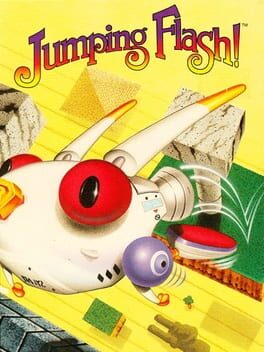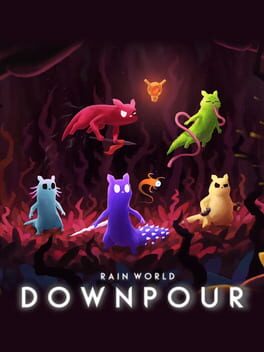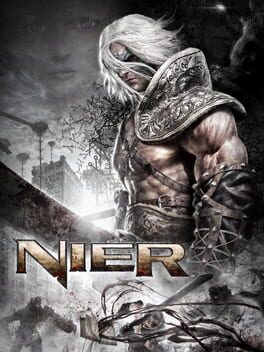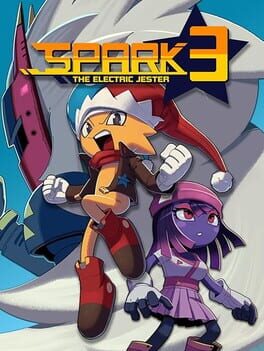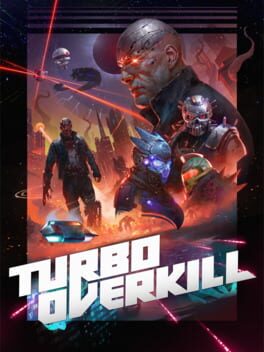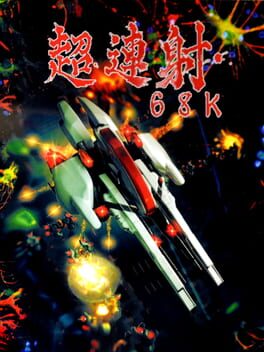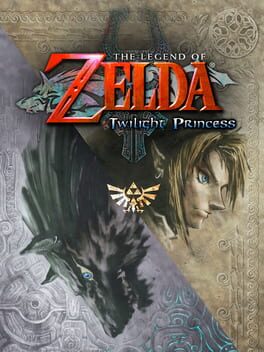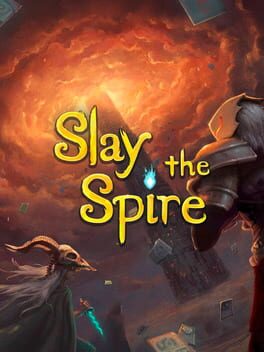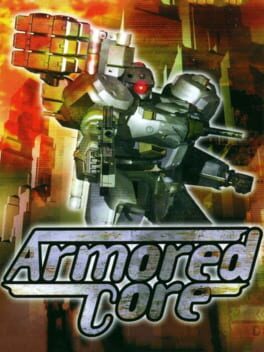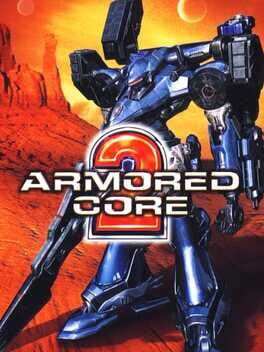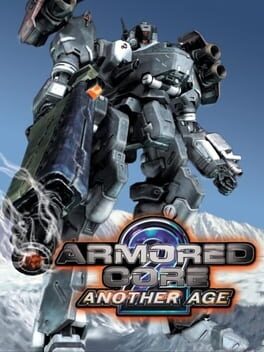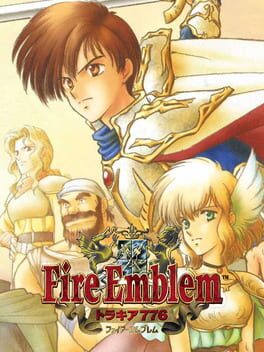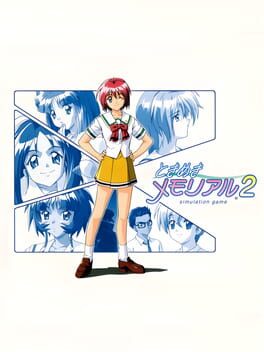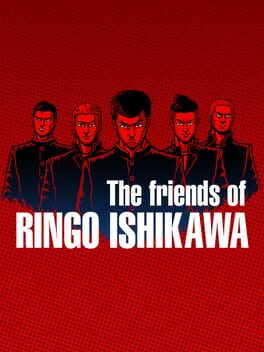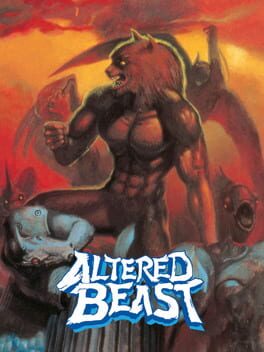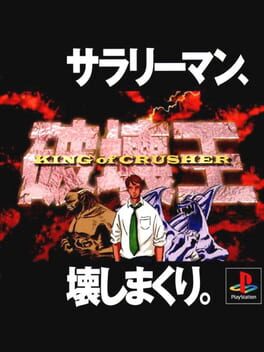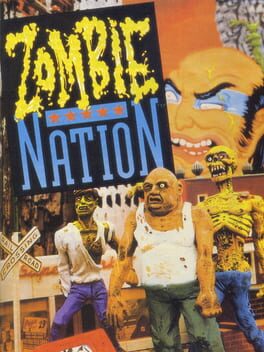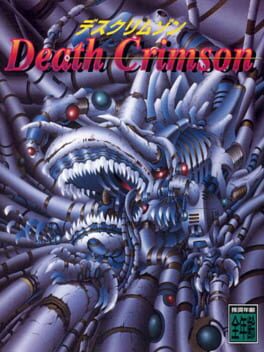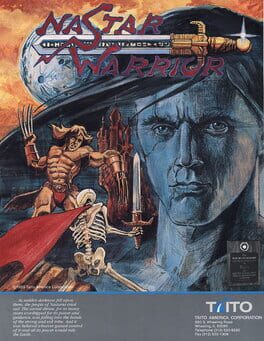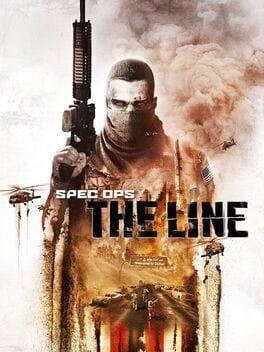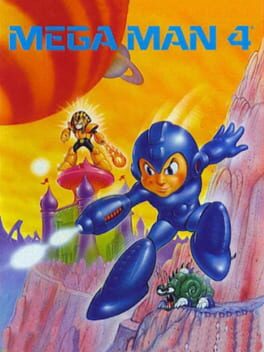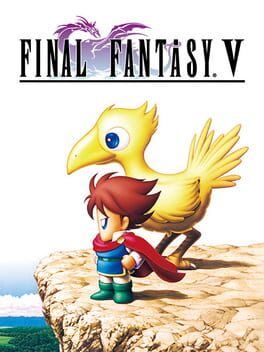JordanResin
867 reviews liked by JordanResin
Rain World
2017
Pikmin
2001
The secret behind Pikmin’s success was not that it somehow outclassed classic real-time strategy franchises, but rather that it was never competing with them to begin with. According to Shigeru Miyamoto, he came up with the idea for Pikmin one day when he observed a group of ants carrying leaves together into their nest. Miyamoto then imagined a game focused on cooperation rather than competition; he asked, “Why can’t everyone just move together in the same direction, carrying things as a team?” Nintendo EAD’s design philosophy went along with this line of reasoning, melding design mechanics from different genres to create an entirely new yet familiar experience. As a result, instead of competing against other players in Pikmin akin to classic RTS games, Pikmin forces players to explore and compete with the very environment itself by introducing puzzle-exploration and survival mechanics. It made sense in the end; after all, real-time strategy is concerned with minimizing time spent to get a competitive edge over opponents, and what better way to translate this than to force players to master their understanding over the terrain itself, managing and optimizing the one resource which governs them all?
Perhaps Nintendo’s greatest challenge was figuring out how to translate a genre considered by many to be niche and technical to an intuitive yet layered game, and even more so, translating classic actions from a mouse and keyboard allowing for such complexity to a suite of simplified controls using a gamepad. Coming from the other side as someone who played Starcraft as a kid and didn’t get into Pikmin until recently however, I’m surprised at how well EAD’s tackled this endeavor. Classic RTS games focus upon base-building and resource gathering through the micromanagement of units. Pikmin’s take upon this is to introduce a dichotomy between the player character Captain Olimar, who is incapable of doing anything by himself but can issue commands to the units only he can create by plucking out of the soil, and the Pikmin, who are essentially brainless but represent the units that must do everything. The player as Olimar must be present to figure out exactly how to best traverse and exploit the environment around him (replacing the base-building with management/prioritization puzzles) while the Pikmin provide bodies to construct, move, and attack the world around them. However, the Pikmin’s AI is fairly limited and as a result, Pikmin will sit around helplessly once they finish their actions and often get distracted by nearby objects while moving around, which is where the micromanagement kicks in. Therefore, the player has to decide how to best build up their supply of Pikmin to allocate tasks to surmount bottlenecks while exploring and opening the world, all while working against the limited thirty-day timer throughout the game’s five areas.
A part of me expected to really struggle with the gamepad while playing Pikmin, but the available actions on offer allow for a surprising degree of control despite the simplification. For instance, consider Olimar’s whistle; as a substitution for dragging and clicking to select units on PC, the whistle on the GameCube lets Olimar quickly rally groups of clustered units. Holding down B for longer allows the player to increase the size of the whistle’s AOE, which allows the player to better control and target how many Pikmin to rally in any cluster (hence, the analog of clicking and dragging to select boxes of units on mouse and keyboard). The Swarm command is another interesting translation. The obvious use is to allow Olimar to quickly move nearby Pikmin by directing them with the C-stick versus needing to aim and throw them by positioning and rotating Olimar himself. However, because it can be used to shift the position of Pikmin with respect to Olimar, it can also be used to swap the Pikmin on-deck for throwing (since Olimar will always throw the Pikmin closest to him) without needing to dismiss and re-rally separated Pikmin colors, and most importantly, it allows you to directly control the group of Pikmin following Olimar while moving Olimar himself. This second application allows the player to kite the Pikmin around telegraphed enemy attacks, and properly funnel them so the Pikmin aren’t getting as easily stuck behind walls or falling off ledges/bridges into hazards. That said, noticeable control limitations do exist. Olimar cannot pivot to move the reticle without changing his position with respect to the Pikmin around him, which can make aiming in place annoying if the Pikmin types you need to throw aren’t close enough to be moved next to Olimar with Swarm. Additionally, there is no way for Olimar to simultaneously and directly control multiple separated groups of Pikmin, which does make allocating tasks a bit slower. However, given that the tasks themselves usually don’t necessitate more than one Pikmin type at a time, this limitation is understandable, especially since the sequels would tackle this challenge with more expansive controls and multiple playable characters on the field.
Pikmin’s base model as a result is a fantastic translation of an abstract design philosophy, but I can’t help but wonder if the original could have been pushed further. Don’t misunderstand me: I absolutely take pride in mastering a game by learning all about its inner workings and pushing its mechanics to the limits simply by following a few intuitive genre principles. As such, I wish that the game was a bit harder in order to really force me to squeeze every bit of time from the game’s solid premise. For example, combat is often optional in Pikmin given how many full-grown Bulborbs are found sleeping, but given that most enemies don’t respawn within the next day after killing them and I can bring their carcasses back to base to more than replenish my Pikmin supply, combat is almost always in my favor, especially since certain enemies will spawn more mobs if they aren’t defeated. If circumstances existed where it would be unfavorable to engage (such as losing a significant number of Pikmin every time, or having so little time left that engaging would waste time), then I feel that this would add an additional layer of decision-making of deciding when to sneak past sleeping Bulborbs rather than just wiping out as many foes as I could as soon as possible. In a similar sense, I felt that certain design elements such as the Candypop Buds for switching Pikmin colors were a bit underutilized; outside of one environmental puzzle, I never had to use the Candypop Buds, mainly because I had so many remaining Pikmin and time to never justify their usage. I’ll concede here that Pikmin’s one-day Challenge Mode does at least provide a score attack sandbox where I’m forced to take my Pikmin stock and remaining time into higher consideration, but it’s missing the connectivity of the main story mode where my earlier actions would greatly affect how I planned later days in a run, particularly in making judgement calls on which days to spend at each site and which days I dedicate towards building up my Pikmin numbers versus hauling in ship parts. Regardless, I found myself completing the main game with all parts in just twenty days on my first run with minimal resets, and I’d love to try a harder difficulty mode with a stricter time limit and tougher Pikmin margins to really force me to better conserve my working force and dedicate more time to restocking my supply.
Gripes aside, I’m glad that my friends finally convinced me to try out Pikmin, not just to better appreciate RTS games as a whole but to also gain an appreciation of how different genre mechanics can work in tandem to intuitively convey concepts without spelling everything out to the player. It’s classic Nintendo at their core, and while I had my reservations coming in as a fan of older RTS franchises, they’ve managed to convince me once again that the best hook is not simply offering something that’s visibly better, but rather offering something that’s visibly different. I still think that there’s improvement to be had, but given how much I’ve enjoyed the first game, I can’t wait to see what they have to offer from iterating upon their memorable beginnings.
Perhaps Nintendo’s greatest challenge was figuring out how to translate a genre considered by many to be niche and technical to an intuitive yet layered game, and even more so, translating classic actions from a mouse and keyboard allowing for such complexity to a suite of simplified controls using a gamepad. Coming from the other side as someone who played Starcraft as a kid and didn’t get into Pikmin until recently however, I’m surprised at how well EAD’s tackled this endeavor. Classic RTS games focus upon base-building and resource gathering through the micromanagement of units. Pikmin’s take upon this is to introduce a dichotomy between the player character Captain Olimar, who is incapable of doing anything by himself but can issue commands to the units only he can create by plucking out of the soil, and the Pikmin, who are essentially brainless but represent the units that must do everything. The player as Olimar must be present to figure out exactly how to best traverse and exploit the environment around him (replacing the base-building with management/prioritization puzzles) while the Pikmin provide bodies to construct, move, and attack the world around them. However, the Pikmin’s AI is fairly limited and as a result, Pikmin will sit around helplessly once they finish their actions and often get distracted by nearby objects while moving around, which is where the micromanagement kicks in. Therefore, the player has to decide how to best build up their supply of Pikmin to allocate tasks to surmount bottlenecks while exploring and opening the world, all while working against the limited thirty-day timer throughout the game’s five areas.
A part of me expected to really struggle with the gamepad while playing Pikmin, but the available actions on offer allow for a surprising degree of control despite the simplification. For instance, consider Olimar’s whistle; as a substitution for dragging and clicking to select units on PC, the whistle on the GameCube lets Olimar quickly rally groups of clustered units. Holding down B for longer allows the player to increase the size of the whistle’s AOE, which allows the player to better control and target how many Pikmin to rally in any cluster (hence, the analog of clicking and dragging to select boxes of units on mouse and keyboard). The Swarm command is another interesting translation. The obvious use is to allow Olimar to quickly move nearby Pikmin by directing them with the C-stick versus needing to aim and throw them by positioning and rotating Olimar himself. However, because it can be used to shift the position of Pikmin with respect to Olimar, it can also be used to swap the Pikmin on-deck for throwing (since Olimar will always throw the Pikmin closest to him) without needing to dismiss and re-rally separated Pikmin colors, and most importantly, it allows you to directly control the group of Pikmin following Olimar while moving Olimar himself. This second application allows the player to kite the Pikmin around telegraphed enemy attacks, and properly funnel them so the Pikmin aren’t getting as easily stuck behind walls or falling off ledges/bridges into hazards. That said, noticeable control limitations do exist. Olimar cannot pivot to move the reticle without changing his position with respect to the Pikmin around him, which can make aiming in place annoying if the Pikmin types you need to throw aren’t close enough to be moved next to Olimar with Swarm. Additionally, there is no way for Olimar to simultaneously and directly control multiple separated groups of Pikmin, which does make allocating tasks a bit slower. However, given that the tasks themselves usually don’t necessitate more than one Pikmin type at a time, this limitation is understandable, especially since the sequels would tackle this challenge with more expansive controls and multiple playable characters on the field.
Pikmin’s base model as a result is a fantastic translation of an abstract design philosophy, but I can’t help but wonder if the original could have been pushed further. Don’t misunderstand me: I absolutely take pride in mastering a game by learning all about its inner workings and pushing its mechanics to the limits simply by following a few intuitive genre principles. As such, I wish that the game was a bit harder in order to really force me to squeeze every bit of time from the game’s solid premise. For example, combat is often optional in Pikmin given how many full-grown Bulborbs are found sleeping, but given that most enemies don’t respawn within the next day after killing them and I can bring their carcasses back to base to more than replenish my Pikmin supply, combat is almost always in my favor, especially since certain enemies will spawn more mobs if they aren’t defeated. If circumstances existed where it would be unfavorable to engage (such as losing a significant number of Pikmin every time, or having so little time left that engaging would waste time), then I feel that this would add an additional layer of decision-making of deciding when to sneak past sleeping Bulborbs rather than just wiping out as many foes as I could as soon as possible. In a similar sense, I felt that certain design elements such as the Candypop Buds for switching Pikmin colors were a bit underutilized; outside of one environmental puzzle, I never had to use the Candypop Buds, mainly because I had so many remaining Pikmin and time to never justify their usage. I’ll concede here that Pikmin’s one-day Challenge Mode does at least provide a score attack sandbox where I’m forced to take my Pikmin stock and remaining time into higher consideration, but it’s missing the connectivity of the main story mode where my earlier actions would greatly affect how I planned later days in a run, particularly in making judgement calls on which days to spend at each site and which days I dedicate towards building up my Pikmin numbers versus hauling in ship parts. Regardless, I found myself completing the main game with all parts in just twenty days on my first run with minimal resets, and I’d love to try a harder difficulty mode with a stricter time limit and tougher Pikmin margins to really force me to better conserve my working force and dedicate more time to restocking my supply.
Gripes aside, I’m glad that my friends finally convinced me to try out Pikmin, not just to better appreciate RTS games as a whole but to also gain an appreciation of how different genre mechanics can work in tandem to intuitively convey concepts without spelling everything out to the player. It’s classic Nintendo at their core, and while I had my reservations coming in as a fan of older RTS franchises, they’ve managed to convince me once again that the best hook is not simply offering something that’s visibly better, but rather offering something that’s visibly different. I still think that there’s improvement to be had, but given how much I’ve enjoyed the first game, I can’t wait to see what they have to offer from iterating upon their memorable beginnings.
Jumping Flash!
1995
If I could jump that high...would I ever find the ground again?
Is it bad to jump that high into the sky of nostalgia? To let yourself slip away and put your head into the clouds? Will those clouds of nostalgia turn you against your peers who don't see the vision? The vision of a children's playground for you to jump around to your heart's content? Planting yourself on a little conveyor and riding on it like a first-person roller coaster? Pretending to pet the non-threatening round green birds that chirp "kiwi!" if you dare to shoot them?
I wish I could jump like Robbit, I wish I could shoot lasers like Robbit, and I wish I could make funny noises whenever I took a step forward like Robbit. Why is life such a bore? Why can't it be just playgrounds and rainbows? Why can I not be just like my hero Robbit? Fighting funny evil men with funny palm tree jellyfish henchmen.
Was it my mom's fault that she bought me this during a time where I got nothing for a majority of the year due to being a poor December baby? Is she to blame for this mess? My poisonous care for a simple video game that I had played too much? The rare time where I can attach my mom to a game instead of my gamer dad? My yearning for days that I didn't need to care about getting up for work in the morning? When I didn't have a constant worry for the struggles of others? Is it truly bad for me? To just make me forget, and make me care only about smiling and struggling to hold back my emotions? To just, feel once more?
Is it bad for me to feel like a kid again? For just one hour?
Why must life be so grounded...?
Let's go Robbit, let's jump and go...for old times' sake once more....
Is it bad to jump that high into the sky of nostalgia? To let yourself slip away and put your head into the clouds? Will those clouds of nostalgia turn you against your peers who don't see the vision? The vision of a children's playground for you to jump around to your heart's content? Planting yourself on a little conveyor and riding on it like a first-person roller coaster? Pretending to pet the non-threatening round green birds that chirp "kiwi!" if you dare to shoot them?
I wish I could jump like Robbit, I wish I could shoot lasers like Robbit, and I wish I could make funny noises whenever I took a step forward like Robbit. Why is life such a bore? Why can't it be just playgrounds and rainbows? Why can I not be just like my hero Robbit? Fighting funny evil men with funny palm tree jellyfish henchmen.
Was it my mom's fault that she bought me this during a time where I got nothing for a majority of the year due to being a poor December baby? Is she to blame for this mess? My poisonous care for a simple video game that I had played too much? The rare time where I can attach my mom to a game instead of my gamer dad? My yearning for days that I didn't need to care about getting up for work in the morning? When I didn't have a constant worry for the struggles of others? Is it truly bad for me? To just make me forget, and make me care only about smiling and struggling to hold back my emotions? To just, feel once more?
Is it bad for me to feel like a kid again? For just one hour?
Why must life be so grounded...?
Let's go Robbit, let's jump and go...for old times' sake once more....
Rain World
2017
No greater indictment of the gaming press than the scorn for one of the most innovative games to come out since Demon's Souls. It's a game all about intrinsic reward as really most platformers are but in something like Super Metroid there is a reward in the way of powerups, the reward in Rain World is simply living to the next area and seeing what practical joke will be played on you.
I haven't seen a game that showed this much restraint since Ico. The game could've given you upgrades, a final boss, a significant crutch, a more present story, really anything your usual metroidvania would do but it didnt. The few concessions to minimalism like the map and the titles of the areas being shown never dampened the extreme immersive quality this game granted me.
Despite being quite game-y, this game probably bridges the cold reality of the world to the player in the best way possible, not simply because the game is "unfairly designed" but because it does actually feel like a real breathing ecosystem, the scavengers or lizards arent just obstacles for the player to engage in, they act like how animals would in real life, they go on living their life independent of the protagonists existence.
Very sad that in the mid 2010s indie game hype wave, this genius title comparatively got left out. I had only learned about this game in 2019 from Matthewmatosis and put it on the backburner till now.
I haven't seen a game that showed this much restraint since Ico. The game could've given you upgrades, a final boss, a significant crutch, a more present story, really anything your usual metroidvania would do but it didnt. The few concessions to minimalism like the map and the titles of the areas being shown never dampened the extreme immersive quality this game granted me.
Despite being quite game-y, this game probably bridges the cold reality of the world to the player in the best way possible, not simply because the game is "unfairly designed" but because it does actually feel like a real breathing ecosystem, the scavengers or lizards arent just obstacles for the player to engage in, they act like how animals would in real life, they go on living their life independent of the protagonists existence.
Very sad that in the mid 2010s indie game hype wave, this genius title comparatively got left out. I had only learned about this game in 2019 from Matthewmatosis and put it on the backburner till now.
Rain World: Downpour
2023
Some of the most fun I’ve had with a game in years was learning how to kill lizards in Rain World. In my entire time with the game in my first playthroughs, I’m not sure I ever intentionally killed one of these beasts. I saw them as impossible foes. But in order to reach many of my goals in Downpour, I had to learn how to conquer them. The first kill feels like a fluke, like luck, and in a way it is. But each spear that pierces their hide feels more real, more earned. They never stop being terrifying. They never stop being a threat. But I had to learn how to take them down anyway, backflipping, juking, stabbing, feasting. I had to learn how to slay dragons.
I have a brand, and part of that brand is that I really like Rain World. In all my poetic waxings, I often am remiss to mention what makes playing Rain World itself actually so cool. So for once, I’ll try to offer an admittedly vague explanation. I’m sure you can find no shortage of mechanical rundowns, so I’ll keep this brief: Rain World is a unique game where you play as a little slugcat trying to survive and find shelter before the devastating rain comes. It’s quite a difficult game where challenges may often feel insurmountable. What makes Rain World such a unique game is its emphasis on emergent and procedural systems. The vast majority of these systems are not explained to the player at all, and as such have to be learned by experimentation and exploration. The behavior and animations of all the predators and creatures you encounter is unpredictable and dynamic. The game is a bountfiul garden of consistently surprising gameplay.
The result, for me, is something unlike anything else: a constantly exciting game. It’s always a thrill playing Rain World. Even dozens of hours in, I find myself yelping and gritting my teeth. I can get into specifics but I don’t want to dispel the magic of experiencing it yourself. I adore this. It can also end up making making the game agonizing. This is why initial critical response was negative, and why many players will find the game simply too hard or too cruel to even play let alone enjoy. But that agony is a part of the experience, or at least my experience, and it’s part of what makes the slugcat’s journey so beautiful.
So what about Downpour? This is an expansion that adds a litany of new features. If you just want a straight recommendation, I don’t advise going into anything related to the expansion before playing the base game. It’s not a required expansion and frankly is extremely geared towards die-hard fans. Most of my time was spent with the new slugcats, but they also added co-op, Expedition mode, challenges, and other stuff. A major addition to the game was Remix, a suite of new options that is available to owners of the base game. This alone makes recommending Rain World significantly easier, because it now comes with a big list of checkboxes that can help you tailor the game to your own needs. (If you want help figuring out what to use, check out my forum post here.)
Now, there is a criticism that Downpour in many ways actually distorts and weakens the unique core identity of Rain World. I’m torn on this. On one hand, I think it’s a bit paranoid. Even with an expansion (which is still optional!), Rain World remains a singular game like no other. Hunter and Monk were already additions and didn’t distort that vision. On the other hand, this game has a lot of things in it. There’s five new campaigns, a bunch of new game modes, and major additions to the map. There’s a chunk of community easter eggs, which frankly rubs me the wrong way, and the involvement of fandom in art can get ugly fast. The expansion also ends up adding a fair bit to the lore and narrative, and I don’t have simple feelings about some of the choices. (I won’t get into it for spoiler reasons, but there are some big swings that I don’t love.) It’s so much that I couldn’t possibly cover it all, and all the implications and complications in this review; even what I’ve written here is longer than I wanted. I wanted to just talk about the lizards, but this is too dense with content that I can’t just leave it at that. I would never go as far to say that Downpour ruins or fundamentally changes Rain World, but it does definitely add a lot to the mix.
There’s a reason for all this. Let’s talk a bit about the history here: years ago, some Rain World modders began developing the More Slugcats mod, which would add new playable slugcats to the game. Eventually, Videocult took these folks onto the team directly and made the expansion official. This, perhaps, explains why there is a sort of eagerness and lack of restraint to the expansion. The developers have announced intent to continue working on Rain Word, though I get the sense that this will mostly be the Downpour team and not the Videocult duo. I won’t lie that this concerns me; I don’t necessarily want to see this game endlessly expanded. I’m still waiting on the Signal project, and I want to see what else these teams are capable of putting together.
I think part of this comes from the fact that I don’t really engage with games in the way a lot of others seem to. For some people, Rain World is there forever game. I don’t want a forever game. I don’t generally seek to play a game for an indeterminately long amount of time. When I see credits on a roguelite, that’s generally when I stop playing. I am so puzzled when I see people gripe about growing tired of something after several hundred hours in a game. Even my favorite games of all time I generally do not return to ad nauseaum.
But that’s sort of why Downpour ends up making me happy. In spite of some of my concerns and gripes. A messier Rain World is still Rain World, and Rain World is good. And at the end of the day, Downpour gave me a reason to play one of my favorite games again. It gave me a reason to learn how to slay dragons. And that’s worth a hell of a lot.
I have a brand, and part of that brand is that I really like Rain World. In all my poetic waxings, I often am remiss to mention what makes playing Rain World itself actually so cool. So for once, I’ll try to offer an admittedly vague explanation. I’m sure you can find no shortage of mechanical rundowns, so I’ll keep this brief: Rain World is a unique game where you play as a little slugcat trying to survive and find shelter before the devastating rain comes. It’s quite a difficult game where challenges may often feel insurmountable. What makes Rain World such a unique game is its emphasis on emergent and procedural systems. The vast majority of these systems are not explained to the player at all, and as such have to be learned by experimentation and exploration. The behavior and animations of all the predators and creatures you encounter is unpredictable and dynamic. The game is a bountfiul garden of consistently surprising gameplay.
The result, for me, is something unlike anything else: a constantly exciting game. It’s always a thrill playing Rain World. Even dozens of hours in, I find myself yelping and gritting my teeth. I can get into specifics but I don’t want to dispel the magic of experiencing it yourself. I adore this. It can also end up making making the game agonizing. This is why initial critical response was negative, and why many players will find the game simply too hard or too cruel to even play let alone enjoy. But that agony is a part of the experience, or at least my experience, and it’s part of what makes the slugcat’s journey so beautiful.
So what about Downpour? This is an expansion that adds a litany of new features. If you just want a straight recommendation, I don’t advise going into anything related to the expansion before playing the base game. It’s not a required expansion and frankly is extremely geared towards die-hard fans. Most of my time was spent with the new slugcats, but they also added co-op, Expedition mode, challenges, and other stuff. A major addition to the game was Remix, a suite of new options that is available to owners of the base game. This alone makes recommending Rain World significantly easier, because it now comes with a big list of checkboxes that can help you tailor the game to your own needs. (If you want help figuring out what to use, check out my forum post here.)
Now, there is a criticism that Downpour in many ways actually distorts and weakens the unique core identity of Rain World. I’m torn on this. On one hand, I think it’s a bit paranoid. Even with an expansion (which is still optional!), Rain World remains a singular game like no other. Hunter and Monk were already additions and didn’t distort that vision. On the other hand, this game has a lot of things in it. There’s five new campaigns, a bunch of new game modes, and major additions to the map. There’s a chunk of community easter eggs, which frankly rubs me the wrong way, and the involvement of fandom in art can get ugly fast. The expansion also ends up adding a fair bit to the lore and narrative, and I don’t have simple feelings about some of the choices. (I won’t get into it for spoiler reasons, but there are some big swings that I don’t love.) It’s so much that I couldn’t possibly cover it all, and all the implications and complications in this review; even what I’ve written here is longer than I wanted. I wanted to just talk about the lizards, but this is too dense with content that I can’t just leave it at that. I would never go as far to say that Downpour ruins or fundamentally changes Rain World, but it does definitely add a lot to the mix.
There’s a reason for all this. Let’s talk a bit about the history here: years ago, some Rain World modders began developing the More Slugcats mod, which would add new playable slugcats to the game. Eventually, Videocult took these folks onto the team directly and made the expansion official. This, perhaps, explains why there is a sort of eagerness and lack of restraint to the expansion. The developers have announced intent to continue working on Rain Word, though I get the sense that this will mostly be the Downpour team and not the Videocult duo. I won’t lie that this concerns me; I don’t necessarily want to see this game endlessly expanded. I’m still waiting on the Signal project, and I want to see what else these teams are capable of putting together.
I think part of this comes from the fact that I don’t really engage with games in the way a lot of others seem to. For some people, Rain World is there forever game. I don’t want a forever game. I don’t generally seek to play a game for an indeterminately long amount of time. When I see credits on a roguelite, that’s generally when I stop playing. I am so puzzled when I see people gripe about growing tired of something after several hundred hours in a game. Even my favorite games of all time I generally do not return to ad nauseaum.
But that’s sort of why Downpour ends up making me happy. In spite of some of my concerns and gripes. A messier Rain World is still Rain World, and Rain World is good. And at the end of the day, Downpour gave me a reason to play one of my favorite games again. It gave me a reason to learn how to slay dragons. And that’s worth a hell of a lot.
Rain World
2017
I'll confess that I've only played about 20 minutes of this game, so I'm not really reviewing it for myself, but for my best friend who passed away in March. We lived together so we would hang out and talk about video games almost everyday and before he passed away THIS was his favorite game, full-stop.
It's hard to describe how much I miss chatting with him about Rain World, it made him passionate about game ideas he was programming and passionate about games in general, it was exciting to see him have that spark for making art again. It's cringey, but I wish I could message the developers and let them know how much it meant to my friend that this game even EXISTED, let alone that it was this amazing to him.
The last conversation I ever had with him he was telling me about the lore for Rain World, how he beat every piece of content in it just to learn more about the story, and to my surprise, I found in one of his journals pages of him deciphering the lore and studying it on his own for fun.
It'll be a long while before I'm able to play any of his favorite games again, but I'm going to rate this a 5 on his behalf anyway, as I have no doubt in my mind it's what he would have given it. I'll never know why he chose to leave, but I at least have this game that spoke to him in a way you wish all art could, and as much as I wish he was here to tell you why it's a 5-star game, you'll just have to take my word for it. This was a perfect game to him, and he had way better taste than me!
It's hard to describe how much I miss chatting with him about Rain World, it made him passionate about game ideas he was programming and passionate about games in general, it was exciting to see him have that spark for making art again. It's cringey, but I wish I could message the developers and let them know how much it meant to my friend that this game even EXISTED, let alone that it was this amazing to him.
The last conversation I ever had with him he was telling me about the lore for Rain World, how he beat every piece of content in it just to learn more about the story, and to my surprise, I found in one of his journals pages of him deciphering the lore and studying it on his own for fun.
It'll be a long while before I'm able to play any of his favorite games again, but I'm going to rate this a 5 on his behalf anyway, as I have no doubt in my mind it's what he would have given it. I'll never know why he chose to leave, but I at least have this game that spoke to him in a way you wish all art could, and as much as I wish he was here to tell you why it's a 5-star game, you'll just have to take my word for it. This was a perfect game to him, and he had way better taste than me!
Rain World
2017
Some kind of a miracle had to have happened to let this game come out today. Between the buddhism, virtual ecology and perfect ludonarrative harmony, Rain World isn't just difficult, it's Nintendo-hard. While panned at release, Rain World's method of difficulty isn't anything new, and it's not even comparable to something like the Souls-series due to the degree of randomization and lack of tactile combat. No, it's a modern day Famicom game through-and-through. Characterized by the historical respawning off-screen enemies that can one-shot you, punishing consequences for death, methodical calculative movement, cryptic progression and a constant timer ticking down on the player. Rain World isn't innovative in its methods of difficulty, but it's innovative in how it achieves those methods, which is where the modernization comes in. Extremely rich detailed ecosystems with constantly varying placements of enemies due to their own intelligence telling them where they belong rather than a designers hand and varying lengths of cycles turns you into a gambler each time you go back into nature. For people who think the best video games are oft as simple as a good challenging gauntlet alike classic NES titles, then Rain World may be to them, a legitimate contender for the best game of all time thanks to the fact it's a gruelling challenge generator that wastes no time taking the pressure off you. I, also, am one of these people, and if you ask me for what game has the most consistently engaging gameplay ever, even without the incredible theming, presentation and emotionally impactful ending, it'd be Rain World.
The "New" was only ever entirely literal: disappointingly, that subseries was essentially a Mario highlight reel rather than anything actually new. Of course, novelty isn't tantamount to quality, but it often feels like Nintendo's only strength as a developer in the modern age is their willingness to experiment. We'll never see another first-party Nintendo game that's not painfully easy and overtutorialized, or one that pushes its mechanics and is at all willing to punish you, or even one that feels mysterious, but buy a Nintendo console and you'll still always end up with a handful of exclusives that are at least fresh conceptually. Just... without "Mario" in any of their titles. Galaxy is far from my favorite Mario game, but it's the most recent one that actually felt like something new, which is concerning considering that it released when most of this site's userbase was still in diapers. We're in the mid 2020s now and traditional, lives-and-continues-based 2D platformers are basically dead and buried, but here comes Super Mario Bros. Wonder with what seems to be a singular, concentrated effort to be new and not just New. You can turn into an elephant in this one!
Unfortunately, though, the elephant powerup is even more emblematic of the entire game than anyone could've anticipated. It looks completely unique to Mario, and, I guess, technically, it is, as he's never had an upgrade that requires him to reload his projectiles before, but does it actually change the gameplay in any meaningful capacity? No. It's just another way to break blocks and attack enemies horizontally. The whole game is preoccupied with appearing new instead of actually being new, and, I mean, it succeeded in this regard, considering I actually bought it after skipping both New Super Mario Bros. U and Bowser's Fury. Wonder flowers feel less like a central gameplay hook and more like short bonus sections that are part of already minuscule levels. The only way they were ever gonna work from a mechanical perspective was if they all happened during high-pressure situations and forced you to adapt to unpredictable twists on the fly (although that would just be a rehash of Wario Land 4) and the only way they were ever gonna work from a spectacle perspective was if they actually went all in. For every wonder section that genuinely took me by surprise- switching the point-of-view to top-down or putting me in outer space or making Mario really, really tall- there'd be five that would just turn the level into an autoscroller, or just make the enemies bigger, or just move the geometry around more than usual. Too often, it's weird in the same way that Mario Land 2 is weird: visually, and that's it. Ultimately, it's far prettier than the New Super Mario Bros. games, but it's no less bland.
And outside of the wonder sections, there really just isn’t all that much to talk about. The badge system makes Mario’s moveset loose and flexible akin to something like Yoshi’s Island, but it’s missing the level variety and mechanical experimentation that made that game work. A few stages have bonus exits, but they lack any of Super Mario World’s pseudo-puzzle solving or sense of mystery. What’s left? The fact that it has a handful of decent stage-specific mechanics? (All of the other New games do, too.) Those one-screen puzzle levels? (Didn’t care for them in Mario Maker, still don’t here.) The weird, Dark Souls-ass asynchronous co-op? (I refuse to pay for Nintendo’s online service, so I can’t comment.) How every individual world feels like its own little adventure? (Alright, I admit it, I liked this one.) If you’re not going to be new, you could at least be cohesive- I’m a big fan of both 3D World and Odyssey, but I’d hesitate to call either of them particularly revolutionary, instead focusing on being a conduit for co-op shenanigans and a modernization of Mario 64’s mechanics, respectively. Besides being bright and colorful, is there a similar underlying summary that you could apply to Wonder? More and more, it feels like Mario is becoming Kirby: not striving for anything beyond a vaguely pleasant experience and producing no bad games, but no great ones either. Maybe my standards are just too high- after all, we don't expect Star Wars or The Simpsons or Halloween to be cutting-edge anymore, even though they were at one point, so why should we Mario? But, in 2024, this franchise is unrecognizable from the one that gave us 3's level map and World's secret exits and 64's moveset. And that just saddens me more than anything else.
Unfortunately, though, the elephant powerup is even more emblematic of the entire game than anyone could've anticipated. It looks completely unique to Mario, and, I guess, technically, it is, as he's never had an upgrade that requires him to reload his projectiles before, but does it actually change the gameplay in any meaningful capacity? No. It's just another way to break blocks and attack enemies horizontally. The whole game is preoccupied with appearing new instead of actually being new, and, I mean, it succeeded in this regard, considering I actually bought it after skipping both New Super Mario Bros. U and Bowser's Fury. Wonder flowers feel less like a central gameplay hook and more like short bonus sections that are part of already minuscule levels. The only way they were ever gonna work from a mechanical perspective was if they all happened during high-pressure situations and forced you to adapt to unpredictable twists on the fly (although that would just be a rehash of Wario Land 4) and the only way they were ever gonna work from a spectacle perspective was if they actually went all in. For every wonder section that genuinely took me by surprise- switching the point-of-view to top-down or putting me in outer space or making Mario really, really tall- there'd be five that would just turn the level into an autoscroller, or just make the enemies bigger, or just move the geometry around more than usual. Too often, it's weird in the same way that Mario Land 2 is weird: visually, and that's it. Ultimately, it's far prettier than the New Super Mario Bros. games, but it's no less bland.
And outside of the wonder sections, there really just isn’t all that much to talk about. The badge system makes Mario’s moveset loose and flexible akin to something like Yoshi’s Island, but it’s missing the level variety and mechanical experimentation that made that game work. A few stages have bonus exits, but they lack any of Super Mario World’s pseudo-puzzle solving or sense of mystery. What’s left? The fact that it has a handful of decent stage-specific mechanics? (All of the other New games do, too.) Those one-screen puzzle levels? (Didn’t care for them in Mario Maker, still don’t here.) The weird, Dark Souls-ass asynchronous co-op? (I refuse to pay for Nintendo’s online service, so I can’t comment.) How every individual world feels like its own little adventure? (Alright, I admit it, I liked this one.) If you’re not going to be new, you could at least be cohesive- I’m a big fan of both 3D World and Odyssey, but I’d hesitate to call either of them particularly revolutionary, instead focusing on being a conduit for co-op shenanigans and a modernization of Mario 64’s mechanics, respectively. Besides being bright and colorful, is there a similar underlying summary that you could apply to Wonder? More and more, it feels like Mario is becoming Kirby: not striving for anything beyond a vaguely pleasant experience and producing no bad games, but no great ones either. Maybe my standards are just too high- after all, we don't expect Star Wars or The Simpsons or Halloween to be cutting-edge anymore, even though they were at one point, so why should we Mario? But, in 2024, this franchise is unrecognizable from the one that gave us 3's level map and World's secret exits and 64's moveset. And that just saddens me more than anything else.
Rain World
2017
Thirty-five odd years ago, the first Metroid proved that game design wasn't an exact science. Corridors that led to nothing, rooms that looked identical, enemies that could damage you in loading zones. All horrible ideas, stuff that would end up making the game understandably impalatable to the modern tongue, but also important, essential, even, to characterizing a truly hostile world. Later entries in the series significantly neutered this feeling, creating environments that players weren't only comfortable traversing, but staying in for extended periods of time, meticulously collecting every health tank and missile upgrade. It seems apparent that trying to make something genuinely alien will always be at odds with "good" game design, which typically revolves around the familiar, the intuitive, and the satisfying, but it's still a shame that the original Metroid's vision never wound up fully realized.
Until now, that is, and from Adult Swim of all publishers. The Rain World mantra is simple: you don't belong here, this world owes you nothing, and it will give you nothing that you don't take for yourself. You probably won't beat this game, and you definitely won't get 100% map completion. You'll have to excuse the obvious hackery of mentioning both Metroid and Dark Souls in the same review, but it's enchanting the way a first playthrough of Dark Souls is enchanting. A world as harsh as it is beautiful, with the desire to learn more about it your only motivation through its crushing difficulty. But, by comparison, even Lordran offered more kindness. At least, there, stairs were built for your feet and ladders for your arms. There are no bonfires in the rain world, instead your only points of safety constrained, metallic cages, as if complete isolation from the outside world your only true protection from it. Play perfectly for an entire cycle and you still might die to something outside of your control, right before getting to the next shelter. That's bad game design, just like any unfair mechanic is, but Rain World has loftier ambitions than being a well-designed game. Traditionally, unkillable enemies exist to be defeated later in a cinematic, cathartic payoff, but here, predators never stop being terrifying. Neither do heights, neither does the open sky, and neither does rain. Terrain should subtly guide you to where you're supposed to go next, and entrances to new regions definitely shouldn't be unceremoniously hidden in plain sight. We wouldn't want players to miss something important, would we? My only nitpicks come from the few concessions to this mentality. Mainly, the map, which too often serves as a nondiegetic crutch for players to lean on. It's hard to imagine anyone being able to complete the game without it, but that really only reinforces my argument. What's less understandable is the inclusion of the yellow ghosts, which seemingly show up when you're playing badly in order to patronizingly point out food and enemies.
But assessing Rain World's flaws truly puts its monumental strengths into perspective. Because what's possibly more impressive than everything that went right is the sheer amount of things that could've gone wrong. The game could've used upgrades to create a concrete sense of progression, an artificial way to counteract being at the mercy of your environment. The experience could've been cheapened with side characters or a more explicit narrative. If the enemy AI was even slightly more predictable, or the creature design not consistently haunting, then the exhilaration of a chase would've been greatly diminished. If there wasn't an enormously deep bag of tricks to figure out, both regarding how the game works at large and what your character is capable of, then it wouldn't be able to require so much creativity in its minute problem-solving. Things might've gotten stale if every single region didn't have a distinct way to throw you even further out of your element. And none of this stuff would've mattered if each and every screen wasn't individually memorable in how it tests a specific part of your skills, and yet meticulously constructed to feel naturalistic. Locations effortlessly fit together to paint a world where you don't belong, but also one that you can conquer if you're clever, persistent, and lucky enough. As it stands now, Rain World is a supreme balancing act, its resounding success as improbable as the survival of a slugcat in the wild. Undoubtedly one of the premiere achievements of the generation, and, hopefully, one of the most important.
Until now, that is, and from Adult Swim of all publishers. The Rain World mantra is simple: you don't belong here, this world owes you nothing, and it will give you nothing that you don't take for yourself. You probably won't beat this game, and you definitely won't get 100% map completion. You'll have to excuse the obvious hackery of mentioning both Metroid and Dark Souls in the same review, but it's enchanting the way a first playthrough of Dark Souls is enchanting. A world as harsh as it is beautiful, with the desire to learn more about it your only motivation through its crushing difficulty. But, by comparison, even Lordran offered more kindness. At least, there, stairs were built for your feet and ladders for your arms. There are no bonfires in the rain world, instead your only points of safety constrained, metallic cages, as if complete isolation from the outside world your only true protection from it. Play perfectly for an entire cycle and you still might die to something outside of your control, right before getting to the next shelter. That's bad game design, just like any unfair mechanic is, but Rain World has loftier ambitions than being a well-designed game. Traditionally, unkillable enemies exist to be defeated later in a cinematic, cathartic payoff, but here, predators never stop being terrifying. Neither do heights, neither does the open sky, and neither does rain. Terrain should subtly guide you to where you're supposed to go next, and entrances to new regions definitely shouldn't be unceremoniously hidden in plain sight. We wouldn't want players to miss something important, would we? My only nitpicks come from the few concessions to this mentality. Mainly, the map, which too often serves as a nondiegetic crutch for players to lean on. It's hard to imagine anyone being able to complete the game without it, but that really only reinforces my argument. What's less understandable is the inclusion of the yellow ghosts, which seemingly show up when you're playing badly in order to patronizingly point out food and enemies.
But assessing Rain World's flaws truly puts its monumental strengths into perspective. Because what's possibly more impressive than everything that went right is the sheer amount of things that could've gone wrong. The game could've used upgrades to create a concrete sense of progression, an artificial way to counteract being at the mercy of your environment. The experience could've been cheapened with side characters or a more explicit narrative. If the enemy AI was even slightly more predictable, or the creature design not consistently haunting, then the exhilaration of a chase would've been greatly diminished. If there wasn't an enormously deep bag of tricks to figure out, both regarding how the game works at large and what your character is capable of, then it wouldn't be able to require so much creativity in its minute problem-solving. Things might've gotten stale if every single region didn't have a distinct way to throw you even further out of your element. And none of this stuff would've mattered if each and every screen wasn't individually memorable in how it tests a specific part of your skills, and yet meticulously constructed to feel naturalistic. Locations effortlessly fit together to paint a world where you don't belong, but also one that you can conquer if you're clever, persistent, and lucky enough. As it stands now, Rain World is a supreme balancing act, its resounding success as improbable as the survival of a slugcat in the wild. Undoubtedly one of the premiere achievements of the generation, and, hopefully, one of the most important.
Rain World
2017
If you had a dream for an entirely original game concept, how much would you be willing to compromise your vision for more sales? If it was possible to quantify such a thing, imagine that making it more appealing to the mainstream by 5% would also increase reception and sales by 5%. Would you stick to your guns and create a completely uncompromised game, even if it meant a Metacritic score of 50? Maybe making it just a little easier or a little more direct would be enough, just so you get to the 70 range and a trickle of word-of-mouth sales. It wouldn’t be a best-seller, but if someone was interested enough to buy it, they would be likely to finish the game with a positive experience.
Rain World decided not to compromise even 1%. This game wants to make a statement about nature, and saw the tiniest bit of compromise to make it fair or predictable as antithetical to the message. For starters, you play as a lonely Slugcat, a defenseless rodent trying to locate the rest of its kind in a journey across an industrial zone overtaken by nature. While predators can snap you up in one bite and machines can crush you effortlessly, all you’re able to do is pick up stuff, throw items, climb, and eat. Your journey is a progression from water lock to water lock, hiding each night from a torrential flood of rain which also kills you instantly. To not starve in the middle of the night, you need to have at least four stocks of food, and surviving a night increases your progression meter by one. Filling this meter to a certain level is required to open the doors between the major areas, but dying means the loss of two levels. This means that to progress to a new area, you have to scour for food sources on a time limit while avoiding unpredictable instant-kill predators and any mistake means you have to repeat the process at least two more times. Once you get to a new area, there isn’t always an immediate water lock, so you have to quickly explore and avoid the new predators after spending most of your time just entering the area in the first place. While those are just the basics, it gives a taste of just how brutal the survival in this game is. I quit the game three times before pushing myself to finish it, and even then I wasn’t exactly having fun.
The reason I'm belaboring the point of just how little fun I had in this uncompromising murderscape is twofold: firstly, to let you know what you’re getting into if you do decide to buy it, which you just might when you hear that secondly, all the pain was worth it. It all paid off. The slow reveal of the game’s themes was absolutely magical. The ending was a perfect mesh of story and gameplay satisfaction, where I felt like I accomplished something and really learned something. It’s the most satisfied I’ve ever felt when completing a game in my entire life. It’s probably going to end up in my top ten games of all time. If all this sounds intriguing to you, and you think you can handle the pain, I’ll be cheering for you every step of the way. Stay dry, Slugcat.
Rain World decided not to compromise even 1%. This game wants to make a statement about nature, and saw the tiniest bit of compromise to make it fair or predictable as antithetical to the message. For starters, you play as a lonely Slugcat, a defenseless rodent trying to locate the rest of its kind in a journey across an industrial zone overtaken by nature. While predators can snap you up in one bite and machines can crush you effortlessly, all you’re able to do is pick up stuff, throw items, climb, and eat. Your journey is a progression from water lock to water lock, hiding each night from a torrential flood of rain which also kills you instantly. To not starve in the middle of the night, you need to have at least four stocks of food, and surviving a night increases your progression meter by one. Filling this meter to a certain level is required to open the doors between the major areas, but dying means the loss of two levels. This means that to progress to a new area, you have to scour for food sources on a time limit while avoiding unpredictable instant-kill predators and any mistake means you have to repeat the process at least two more times. Once you get to a new area, there isn’t always an immediate water lock, so you have to quickly explore and avoid the new predators after spending most of your time just entering the area in the first place. While those are just the basics, it gives a taste of just how brutal the survival in this game is. I quit the game three times before pushing myself to finish it, and even then I wasn’t exactly having fun.
The reason I'm belaboring the point of just how little fun I had in this uncompromising murderscape is twofold: firstly, to let you know what you’re getting into if you do decide to buy it, which you just might when you hear that secondly, all the pain was worth it. It all paid off. The slow reveal of the game’s themes was absolutely magical. The ending was a perfect mesh of story and gameplay satisfaction, where I felt like I accomplished something and really learned something. It’s the most satisfied I’ve ever felt when completing a game in my entire life. It’s probably going to end up in my top ten games of all time. If all this sounds intriguing to you, and you think you can handle the pain, I’ll be cheering for you every step of the way. Stay dry, Slugcat.
60 lists liked by JordanResin
by woodoo |
20 Games
by Nilichi |
11 Games
by Herbert |
100 Games
by Wollom |
27 Games
by flaco |
16 Games
by El_Aleph |
20 Games
by vehemently |
55 Games
by DoctorIssa |
41 Games
by moschidae |
3 Games
by fascinator |
37 Games


